|
Welcome to the latest edition of the newsletter to keep you updated on the Twyni Byw – Sands of LIFE (SoLIFE) Project. Here’s a roundup of recent major work carried out by the project across Wales, and plans for the coming months... |
|
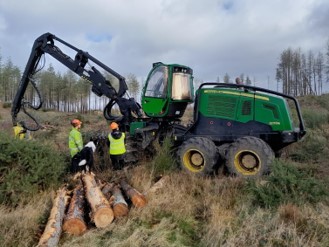 |
|
|
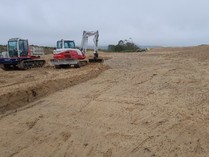
Working with Natural Resources Wales forestry colleagues, nine hectares of conifers were felled from dunes at Morfa Harlech. The conifers impacted the dry dunes and the water levels of nearby dune slacks. The area will benefit from further restoration works over the coming months.
SoLIFE has also restored 2 hectares of overgrown dune slack nearby at the edge of Harlech Forest. We cleared overgrown vegetation and stumps, before scraping away surface layers to expose clean, bare sand. This will create shallow pools in winter and marshy conditions in summer (which will be colonised by rare plants and amphibians); along with drier sand banks that are perfect for solitary bees and other insects.
|
|
|

Earlier this year, two new notches were dug in the frontal dunes at the National Nature Reserve. These channels allow fresh beach sand to blow inland to replenish the supply into the dune system. This creates new bare sand habitat and help boost the specialised dune plants. The SoLIFE team are monitoring this ‘sand rain’ and results will be published in due course.
The next step is to create a series of ‘blowouts’ on the dunes. Excavators will strip the turf from banks facing the prevailing wind to make shallow, bowl-shaped hollows, which specialised plants and animals will colonise. For example, open sunny slopes are favoured by burrowing mining bees.
The annual mowing of around 13 hectares of dune slacks will continue this September. This allows Fen Orchid and other rare plants to flourish without being out-competed by more vigorous species.
|
|
|
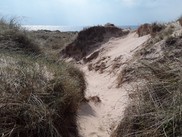 |
|
In September, SoLIFE will also be creating a dune notch at Tywyn Aberffraw. This will connect the beach to the interior dunes, creating bare sand habitat and increasing movement in the dunes. Mitigation measures will protect the resident colony of sand lizards whilst work is underway. |
|
|
Conifer removal also took place at Whiteford Burrows early in 2022. Conifers aren’t native to our dunes and they were planted in the past for timber and to stabilise the once moving sands. The conifers were at the end of their commercial life and at risk of blowing over. Their removal will restore open areas of flower-rich grassland habitat in the dunes. |
|
 |
|
|
|
Conservation work is paying off at the Ministry of Defence’s Pendine Range, as the rare Fen Orchid was re-discovered this year for the first time in 20 years. Read more about the story here.
However, the site still suffers from infestations of Sea Buckthorn, so SoLIFE will be continuing large- scale clearance this autumn by removing 3 hectares of this highly invasive, non-native plant. This will be followed by the erection of nearly 4 kilometres of new fencing to allow grazing, which will keep the restored habitat in good condition.
|
|
|
Grazing is also being brought back to 14 hectares of dunes at Pembrey Burrows, following the installation of 1.5km of new livestock fencing. The area will be grazed by sheep or cattle under the care of Carmarthenshire County Council. The public will still have access via new kissing gates.
We will also be continuing our campaign of Sea Buckthorn control using a combination of root extraction and chemical treatment. This work will help restore the important dune grassland which is host to a range of plant species, including the rare Dune Gentian.
|
|

The mixed herd of cattle and ponies are a familiar sight to Newborough Warren visitors. They have an important role as conservation managers - opening and diversifying the grassland and limiting the growth of scrub and dense vegetation. The current fence is reaching the end of its life, so SoLIFE has replaced 4km out of the 9km required.
Fencing also took place within Newborough Forest at Ffrydiau, allowing livestock to graze the restored glade for the first time. Earlier work to remove scrub and reprofile the pools, is already producing results, as the area is teeming with life.
We will soon be tackling alien species over 8.5 hectares within the surrounding plantation here and at nearby Cerrig Duon, to prevent spread into the biodiversity-rich glades. Cotoneaster, Sea Buckthorn, Montbretia, Laurel, and Rhododendron are species which, if left unmanaged, can take over large areas, smothering native vegetation.
Scraping work will soon be taking place at Gull Slack, Ffrydiau, Pant Mawr and Hendai. Excavators will remove surface layers of overgrown vegetation and forest debris to restore pools, wet slacks and bare sand. The work will allow species such as Shore Dock, rare mosses and liverworts and Great Crested Newts to recolonise.
|
|
|
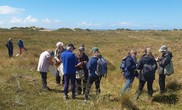
SoLIFE and the Welsh Local Environment Record Centres led guided walks this spring and summer to highlight the fantastic plant and insect life that call this special habitat home. Thanks to Cofnod, WWBIC and SEWBReC for organising the events, especially leaders Phil Ward, Liam Olds, Barry Stewart, Richard and Kath Pryce, Richard Gallon and Lucia Ruffino for their expertise. Find out about upcoming walks at the LERC Eventbrite page.
|
|
|
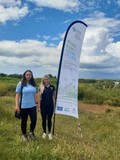
On 25 June, the SoLIFE team celebrated World Sand Dune Day at Kenfig Nature Reserve, showcasing the work of the project locally and across Wales.
Thank you to the hosts Kenfig Corporation Trust and everyone else who joined us on the day, including Plantlife, Dynamic Dunescapes and the Wildlife Trust.
|
|
|
|
Natural Resources Wales, Welsh Government, Natura 2000 and EU LIFE.
SoLIFE: LIFE 17 NAT/UK/000023
The Twyni Byw-Sands of LIFE project has received funding from the LIFE Programme of the European Union
Part funded by Welsh Government
|
|
|
|
|